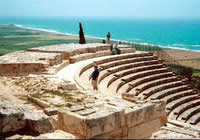|
|
| |
| |
| |
|
| |
 |
| |
|
| uses Google technology and indexes
only and selectively internet - libraries
having books with free public access |
|
 |
|
|
 |
|
| |
|
| |
Previous | |
Next |
|
 |
CLAUDE DELAVAL COBHAM
Exerpta Cypria
page 394 View PDF version of this page Leueusia or Leucosia of tlie Greeks, and present capital of Cyprus. We were detained at Larneca until the evening, by the hospitality of the English Consul, Signor Peristiani, who had prepared a large party of ladies and other inhabitants, all eager tu represent to us the danger of travelling during the day ; and to gratify very reasonable curiosity—for a sight of strangers, and for news fron» Egypt. Among the party was the English Consul from Berytus, from whom I obtained a silver tetradrachm of Tyre, in the highest state of preservation. The interesting costume presented in the dress of the Cyprian ladies ought not to pass without notice. Their head apparel was precisely modelled after the kind of Caìathits repre-sented upon the Phoenician idols of the country, and upon Egyptian statues. This was worn by women of all ranks, from the wives of the Consuls to their slaves. Their hair, dyed of a fine brown colour, by means of a plant called Henna, hung behind, in numerous long straight braids; and in some ringlets disposed near the face were fastened blossoms of the Jasmine, strung together upon slips from leaves of the palm tree in a very curious aud pleasing manner. Next to the Cabnuck women, the Grecian are, of all others, best versed in cosmetic arts. They possess the valuable secret of giving a brown colour to the whitest locks, and also tinge their eye-brows with the same hue ; an art that would be highly prized by the hoary courtezans of London and of Paris. The most splendid colours are displayed in their habits; and these are very becoming to the girls of the island. The upper robe is always of scarlet, crimson or green silk, embroidered with gold. Like other Greek women they wear long scarlet pantaloons, fastened round the ankle ; and yellow boots, with slippers of the same colour. Around the neck, and from the head, were suspended a profusion of gold coins, chains, and other trinkets. About their waists they have a large belt or zone, fastened in front by two large and heavy polished brass plates. They endeavour to make the waist appear as long as possible, and the legs, consequently, short. Naturally corpulent, they take no pains to diminish the size of their bodies by lacing, but seem rather vain of their bulk ; exposing their bosoms, at the same time, in a manner highly unbecoming. Notwith-standing the extraordinary pains they use to disfigure their natural beauty by all sorts of ill-selected ornaments, the women of Cyprus are handsomer than those of any other Grecian island. They have a taller and more stately figure ; and the features, particularly of the women of Nicotia, are regular and dignified, exhibiting that elevated cast of countenance so universally admired in the works of Grecian artists. At present, this kind of beauty seems peculiar to the women of Cyprus; the sort of expression exhibited by one set of features may be traced, with different gradations, in them all. Hence were possibly derived those celebrated models of female beauty conspicuous upon the statues, vases, medals, and gems of Greece; models selected from the throng of Cyprian virgins, who, as priestesses of Venus, officiated at the Paphian shrine. Indefinite as our notions of beauty are said to be, we seldom differ in assigning the place of its abode. That assemblage of graces, which in former ages gave celebrity to the women of Circassia, still characterizes their descendants upon Mount Caucasus; and with the same precision that enables ns to eireninscribe the limits of its residence, we may refer to countries where it never was indigenous. Foremost in the list of these, may be mentioned Egypt. The statues of Isis, and the mummies, exhibit at this hour the countenance common to the females, of the country; nor did the celebrated Cleopatra much differ from the representation thus afforded, if the portrait given of her upon Mark Antony's medals may be considered as authority. There are some countries (for example, Lapland) where it might be deemed impossible to select a single instance of female beauty. Here, it is true, the degraded state of human nature explains the privation. But among more enlightened nations, a traveller would hardly be accused of generalizing
384
EXCERPTA CYPRIA.
View PDF version of this page
|
 |
| |
Previous |
First |
Next |
|
|
|